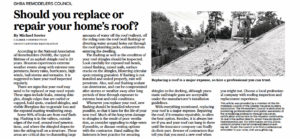Repair or Replace Roof?
This article “Repair or Replace Roof?” was written by By Michael Souter of Caliber Construction Group/Certified Restoration and published in the January 19, 2020 edition of the Houston Chronicle.
 According to the National Association of Homebuilders (NAHB), the typical lifetime of an asphalt shingle roof is 20 years. In Houston we experience extreme weather events along with extreme temperature’s; heavy rains, hurricanes, high winds, hail storms and tornados. It is suggested to have your roof inspected regularly.
According to the National Association of Homebuilders (NAHB), the typical lifetime of an asphalt shingle roof is 20 years. In Houston we experience extreme weather events along with extreme temperature’s; heavy rains, hurricanes, high winds, hail storms and tornados. It is suggested to have your roof inspected regularly.
There are signs that your roof may need to be replaced or may need repair. These signs include leaks, missing shingles, shingle edges that are curled or cupped, bald spots, cracked shingles, and visible fiberglass due to granule loss and the exposed matting weathering away.
90% of leaks are from roof flashing. Flashing is in the valleys, outside edges of the roof, around roof penetrations, and where the shingled slopes tie into the siding/wall on a structure. These areas are critical due to channeling large amounts of water off the roof (valleys), off the siding onto the roof (wall flashing) or diverting water around holes cut through the roof (plumbing jacks, exhausts) from entering the dwelling.
The flashing as well as the condition of your roof shingles should be inspected. Look carefully for exposed nail heads, raised flashing, raised nails, surface cracks on the shingles, blistering (circular spots missing granules). If flashing is not installed and sealed properly rain will penetrate. Also, nail and flashing sealant can deteriorate, and can be compromised after storms or weather away after long periods of time through exposure to extreme heat and cold conditions.
Whenever you replace your roof, new flashing should be installed wherever possible, so that it lasts for the life of your new roof. Much of the long-term damage to shingles is the result of poor ventilation, consider upgrading to ridge vents if possible, or discuss venting options with the contractor. In our experience, hand nailing the fasteners is best practices for securing shingles to the decking, although pneumatic nail/staple guns are acceptable under the manufacturer’s installation guidelines.
With everything mentioned, replacing your roof is a major expense. Repairing the roof, if it remains repairable, is often the best option. Besides, it is always better if you and your roof can hang in there until the insurance company can finally do their part. Beware of contactors that tell you that you need a new roof when you might not. Choose a local professional company with roofing inspection and replacement experience.





